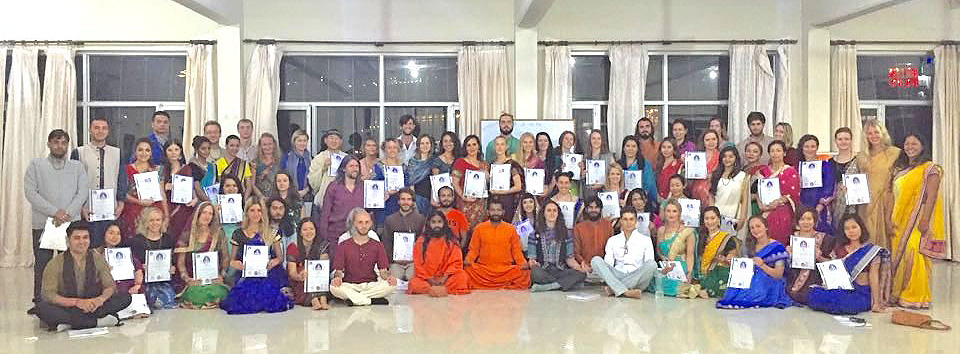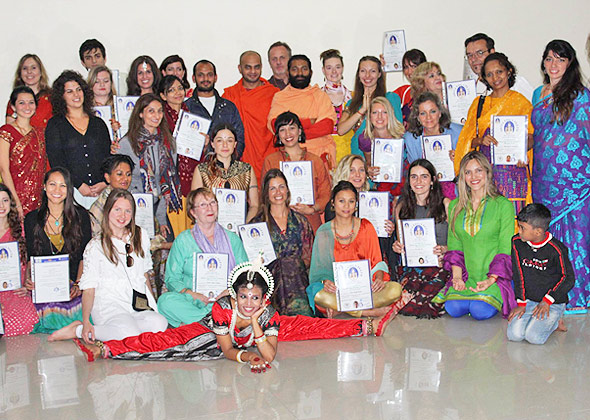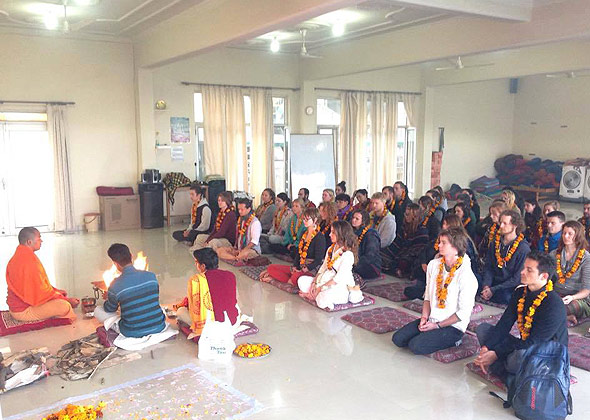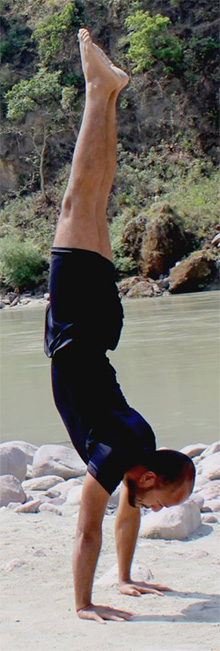200 hour Yoga Teacher Training in Rishikesh, India
The 200 Hour Yoga Teacher Training program at Shiva Yoga Peeth in Rishikesh, India is intended for people with a great skill development interest that are looking to explore it. The course touches each area of yoga and is led by instructors with a solid knowledge of yoga who use their time to present accurate yogic theory. Completing this program will be an incredible metamorphosis for you. The courses included in the program will strengthen your own practice allowing you to use your own experience to start teaching others with confidence.

Traditional Hatha 200 hour Yoga Alliance International certified teacher training program
Shiva Yoga Peeth is a registered organization by Government of India, Yoga Alliance International. This is a world class training institute perfect for both yoga beginners looking to improve their health, happiness, peace and harmony and for those who want to acquire yoga as profession. After successfully completing the Yoga Teacher Training program, the certificate provided is valid all over the world for you to begin your new calling!


Objective of 200 hour Yoga teachers In India course
The main objective of our courses is to allow you to develop a self-practice both spiritually and physically in each of the areas listed below. The modules are categorised into 5 areas:
- Practice
- Anatomy and Physiology of Yogic Practices
- Yoga Philosophy
- Yogic Lifestyle
- Teaching Methodology and Practice
As you develop your spiritual and physical practice, Teaching Methodology then assists you teach what you yourself are practicing. We firmly believe that being a strong practitioner in each of these will give you the grounding and foundations to becoming a successful and confident yoga teacher. Take your first step into something that can change your life. In one month, you’ll finish this training with the necessary tools, skills and insights, to guide you on your journey.
One of the things that’s so rewarding about these 200 hrs intensives, is that each one of us comes to the mat for something different. Our journey is unique to ourselves, yet for 30 days we learn and grow together, become part of the same energy. You will learn to create flows for a variety of class types. Explore what works best for your body. This course offers a complete study of the eight limbs of yoga based upon the Yoga Sutras. Our training is devoted to helping Yoga Teachers teach to all walks of life. Our motto is “yoga for all” Our asana technique explores contemporary principles of alignment and safety, while honouring our students’ need for creativity, freedom, and self-expression in their practice.
Practice
1) Asanas (Postures): You will learn Many postures of Ashtanga, Iyengar, and Hatha Yoga.
Study various asanas and the technique of teaching the postures, the benefits of each posture, modifications, contraindications, and the use of props.
- Standing poses.
- Sitting poses, forward bends and hip openers.
- Sitting/supine twists.
- Back bends.
- Inversions.
- Arm balances.
- Restorative postures.
2) Adjustment: Learn how to adjust these asanas and understand how adjustment can deepen your practice.
3) Pranayama (Breathing Techniques): These are based on traditional yogic breathing techniques which will benefit your yoga practice as you learn how to lengthen your breath. How to incorporate breathing into postures and into your classes. How breath work assists the body.
4) Shatkarma (Cleansing Techniques): These yogic cleansing practices will be integrated into the daily morning schedule and will work in conjunction with the asana practices. These will purify the nervous system and allow your breath to flow freely throughout the body. In expelling toxins from the body, we therefore cleanse it.
5) Yogic Mudras (Energy Seals): Stimulate different parts of the body by sealing in the energy. These are usually used in Pranayama and affect the flow of prana.
6) Bandhas (Energy Locks): How they regulate the flow of energy and assists the practitioner in asana.
7) Meditation: You will cover a range of meditation techniques that will help build concentration and focus in your daily practice. Techniques include Om Chanting, Chakra, candlelight Meditation.
8) Mantras (Chanting): A range of mantras will be taught including the Gayatri Mantra and many more. Find your inner harmony in these sessions.
Anatomy
You will learn anatomy relevant to yoga in order to strengthen the classroom explanations, cues, and corrections of asanas.
- Yoga and Skeletal System, Brain & Nervous System, Respiratory System, Digestive System, Cardiovascular System.
- Effects of kriya, Pranayama, Asanas and Meditation for various disorders.
- Subtle Body Anatomy of the chakras, nadis and the application of chakras energy in the practice of Yoga.
- Introduction to Ayurveda & Yogic Diet.
Yoga Philosophy
This class will focus on introducing you to the basic philosophy, concepts and history of yoga. It will cover the various traditional philosophies and viewpoints, insights from modern research and ways in which the essence of this holistic life-view can be integrated into a modern lifestyle.
- Yoga Sutras (Preface of Patanjali’s yoga Sutra): Study this important text based on the 8 limbs of Ashtanga Yoga. Discover the theory and foundations of yoga as Patanjali describes how to make a connection with the body, mind and spirit.
- Kriya Yoga a methodology to overcome Panch-klesha (5 causes of pain and miseries)
- Raj yoga and Hatha yoga
Teaching Methodology and Practice
Class Observation: You will observe a Class given by one of our experienced yoga teachers as inspiration for the class that you will then prepare.
Teaching Methodology: This class will give you the necessary building blocks to devise your own yoga class. Learn how to motivate your students by teaching inclusively to the range of abilities that you may be faced with.
Peer Teaching: These sessions allow you to practice your teaching skills and get constructive feedback from both your Senior Teachers and your peers on your progress.
Adjustment: Learn how to help your students get deeper into a posture through adjustment.
- Studying yoga lifestyle and the ethics of a yoga teacher
- Studying the attitude and presence of the teacher
- The seat of yoga teacher/teaching as service/why we teach/creating a sacred space
- Ethical guidelines for the student teacher relationship
Creating a class/Sequencing/General teaching points
- Elements of great teaching.
- Classroom organization and set up.
- Creating a class plan.
- Teaching progressively focusing on alignment principles.
- The basic principles of sequencing.
Yoga Teaching Practicum
- Practicing teaching with RYT/ERYT.
- Karma yoga.
- Receiving/giving feedback.
- Group teaching during class hours.
4 Week Curriculum – 200 Hour Yoga Teacher Training In India
| 1. | Asana | 7. | Teaching Practice |
| 2. | Pranayama | 8. | Anatomy and Physiology of Yogic Practice |
| 3. | Meditation | 9. | Yogic Philosophy |
| 4. | Cleansing Processes | 10. | Hatha Yoga Pradipica |
| 5. | Bandhas | 11. | Mantra Recitation |
| 6. | Mudras |
Syllabus of Yoga Courses |
|
| A. Hatha Yoga Asanas |
And many more attractive Asana poses along with this traditional poses.And 45 Asana for final exam.
B. Pranayama and Different types of Meditation (Primary Level)
| 1. | Anuloma Viloma, Nadi Shodhan | 6. | Bhramari |
| 2. | Ujjayi | 7. | Suryabhedena |
| 3. | Sitali | 8. | Chandrabhedana |
| 4. | Sitkari | 9. | Theory of Murccha |
| 5. | Bhastrika | 10. | Theory of Plavini |
C. Kriyas – Cleansing Process
| 1. | Jala Neti | 5. | Kapalabhati |
| 2. | Sutra Neti | 6. | Aganisara |
| 3. | Dhauti (Vamana) | 7. | Trataka |
| 4. | Nauli | 8. | Uddiyana |
D. Recitations
| 1. | Pranava Japa | 2. | Svasti Mantra |
E. Other Practices
| 1. | Five Elements | 3. | Mudras & Bandhas (Locks) |
| 2. | Seven Chakras |
F. Teaching Practice
| 1. | Symptoms of a good teacher | 4. | Clear instruction |
| 2. | Demonstration | 5. | Individual care of each student |
| 3. | Proper alignment |
G. Anatomy and Physiology of Yogic Practice
| 1. | Introduction to Anatomy and Physiology | 4. | Respiratory System |
| 2. | Structure and Function of Brain | 5. | Cardiovascular System |
| 3. | Digestive System | 6. | Musculoskeletal System |
H. Yoga Philosophy
| 1. | Introduction to Indian Philosophy | 5. | Concept of Panch Vritti & Panch Klesha |
| 2. | Concept of Yoga according to Patanjali | 6. | Kriya Yoga- A way to overcome inborn afflictions |
| 3. | Concept of God in Yoga Philosophy | 7. | Ashtanga Yoga- A methodology to overcome suffering |
| 4. | Yamas & Niyamas: Foundation of Yogic Practices | 8. | Introduction to Samkya Philosophy |
I. Sanskrit Numbers
1. Ekam 10. Dasa
2. Dve 11. Ekadasa
3. Trini 12. Dvadasa
4. Catvari 13. Trayodasa
5. Panca 14. Caturdasa
6. Sat 15. Pancadasa
7. Sapta 16. Sodasa
8. Astau 17. Saptadasa
9. Nava 18. Astadasa
J.Asana Poses with detailed alignment
Standing Poses
Tadasana standing
Vrksasana standing
Urdhva Hastasana standing
Urdhva Baddhaguliyasana standing
Paschima Namaskar standing
Utkatasana standing
Virabhadrasana 1 standing
Utthita Trikonasana standing
Utthita Parsvakonasana standing
Ardha Chandrasana standing
Virabhadrasana 2 standing
Virabhadrasana 3 standing
Standing Twisting Poses
Parivrtta Trikonasana standing-twist
Parivrtta Parsvakonasana standing-twist
Standing forward ext Poses
Uttanasana forward ext-standing
Padangusthasana forward ext-standing
Padahastasana forward ext-standing
Prasarita Padottanasana forward ext-standing
Parshvottanasana forward ext-standing
Seated Poses
Dandasana seated
Ekapada Rajakapotasana seated
Baddha Konasana seated
Upavista Konasana seated
Ubhaya Padangusthasana seated
Urdhva Mukha Paschimottanasana seated
Baddha Padmasana seated
Yoga Mudra Padmasana seated
Seated forward ext Poses
Paschimottanasana seated-forward ext
Ardha Baddha Padma Paschimottanasana seated-forward ext
Trianga Mukha Eka Pada Paschimottanasana seated-forward ext
Janu Shirshasana seated-forward ext
Malasana 1 seated-forward ext
Malasana 2 seated-forward ext
Seated twisting Poses
Marichyasana 1 seated-twist
Marichyasana 3 seated-twist
Bharadvajasana 1 seated-twist
Bharadvajasana 2 seated-twist
Backbend Poses
Urdhva Mukha Shvanasana Backbend
Ustrasana backbend
Purvottanasana backbend
Sethu Bandha, Sarvangasana backbend
Urdhva Dhanurasana backbend
Salabhasana backbend
Inversion Poses
Adho Mukha Shvanasana inversion
Supta Konasana inversion
Salamba Sarvangasana inversion
Halasana inversion
Karnapidasana inversion
Eka Pada Sirsasana inversion
Parsvaika Ekapada Sirsasana inversion
Sirshasana inversion
Urdhva Dandasana inversion
Supine Poses
Supta Hasta Padangusthasana A supine
Supta Hasta Padangusthasana B supine
Navasana abdominal
Arm Balance Poses
Adho Mukha Vrksasana arm balance
Pincha Mayurasana arm balance
Bakasana arm balance
Bhujapidasana arm balance
Kukkutasana arm balance
Tolasana arm balance
Restorative Poses
Supta Virasana restorative
Supta Baddhakonasana restorative
Shavasana restorative
K.Ashtanga Yoga Primary series
Behaviour
Each student’s social behavior is of great importance. Student’s will be assessed on thier behavior and these behavioral observations will be considered in thier Yoga Teacher Training certificate.
Prayer has its own significance and it is desirable that students take part in it with a full appreciation.
Additional Information
- The food offered at Shiva Yoga Peeth is vegetarian and based on the sattvic diet.
- The Confirmation Fee of 210 USD must be paid in advance and is non-refundable.
